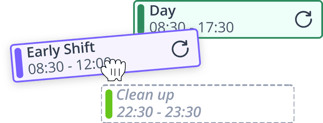Choosing workforce management software for hourly teams can feel like comparing apples to oranges. Every platform promises faster scheduling, cleaner timesheets, and fewer rota headaches, but the details that matter to SMEs (actual cost, payroll integrations, compliance) are often buried. This guide cuts the noise with clear, data-backed recommendations you can act on today.
You’ll see who each tool is best for, what it costs to get started, and where it might fall short. The goal: help you shortlist confidently and avoid buyer’s remorse; whether you run a single café in Leeds or multiple stores across the UK and EU.
Quick comparison table
A fast, side-by-side view to narrow your shortlist in minutes.
| Tool | Best for | Key feature | Starting price* | Rating (source) |
|---|---|---|---|---|
| Shiftbase | Multi-location SMEs that want scheduling + time tracking in one | Skill-based scheduling with budgets & forecasts | Free (up to 10 employees). Paid tiers include first 6–12 employees; add-ons from £3.60–£5.00 per employee/mo (annual) | 4.4/5 Capterra. |
| Deputy | UK hospitality & retail needing rota, T&A and geofencing | Auto-scheduling & labour forecasting | £6.50 per user/mo (Pro). Min monthly spend £20 in UK | 4.6/5 G2. |
| Homebase | Very small teams that want a free plan + add-ons | Free scheduling for 1 location | Free plan; paid plans per location; Payroll add-on from $39 base + $6/employee | 4.3/5 G2. |
| When I Work | Franchises and venues with simple, app-first scheduling | Mobile scheduling with optional time clock | From $2.50 per user/mo (Essentials) | 4.4/5 G2. |
| Connecteam | Deskless/frontline teams wanting fixed-price tiers | Flat pricing for up to 30 users | From $29/mo for first 30 users (annual) | 4.6/5 G2. |
| Planday | UK hospitality with rota compliance needs | Shift planning with working-time rules | From €2.99–€4.99 per user/mo (public ranges) | 4.5/5 G2. |
| QuickBooks Time | Field teams that already use QuickBooks payroll | GPS geofencing + project tracking | £6 per user/mo + £16 base (Premium UK) | 4.5/5 G2. |
⚠️ Prices are vendor-listed at time of writing; many offer annual discounts and regional taxes apply. Always confirm pricing on the vendor page.
Selection criteria
Here’s how we chose the tools, so you can trust the list.
We focused on platforms that (1) are available in the UK and support GBP billing where relevant, (2) serve hourly, shift-based workforces across hospitality, retail, healthcare, facilities, and field services, and (3) publish transparent pricing or widely-cited ranges. We cross-checked user ratings and comments on G2 and Capterra, and validated key features on each official pricing/features page.
-
-
Fit for hourly teams: native rota/scheduling, shifts, time & attendance, mobile clock-in (often with geofencing) and time-off.
-
Proven in SMEs: public case studies or clear adoption in small and mid-sized businesses.
-
Transparent pricing: clear entry price or reputable public range (not “contact sales” only).
-
Integrations & payroll flow: out-of-the-box exports/integrations to UK payroll/accounting where possible (e.g., QuickBooks).
-
Cons surfaced: we noted common limitations from user reviews (e.g., add-on costs, learning curve).
-
-
- Core capability (35%) – scheduling depth, time tracking accuracy, leave management.
- Total cost of ownership (25%) – starter price, base fees, add-ons, likely UK taxes.
- User satisfaction (20%) – recent G2/Capterra average score and review volume.
- Integrations & ecosystem (10%) – payroll/accounting and open API availability.
- UK readiness (10%) – UK pricing pages, data security statements, and local support where stated.
The best workforce management tools for hourly employees in 2026
Here’s a balanced review of seven credible options with UK availability.
1. Shiftbase – Best for multi-location workforce planning
Summary: Shiftbase brings scheduling, time tracking, absence, HR basics and reporting into one platform. Premium adds skill-based scheduling, required shifts, budgets and forecasting—useful when you’re juggling multiple sites and roles. Free plan for very small teams, with clear upgrade paths.
-
Pros: Skill-based scheduling and budget/forecast tools; clean rota building; UK/EU-friendly pricing tiers.
-
Cons: Deeper edits are easier on desktop; learning curve at setup for larger teams. (Reflected in public reviews.)
-
Ideal for: Hospitality, retail, museums, care; 20–500 employees; UK/EU plus global operations.
-
Price overview: Free for up to 10 employees; “Basic” includes first 6 employees; “Premium” includes first 12; then ~£4.50–£5.00 per extra employee/month (annual vs monthly). 14-day free trial.
-
Standout features: Punch clock with location controls; labour-cost forecasting; integration marketplace.
Verdict: Shiftbase is a strong all-in-one for SMEs running multiple locations who need cost control and clear payroll exports without heavy admin.

2. Deputy – Best for compliance-heavy shift operations
Summary: Deputy focuses on AI-assisted rostering, break/overtime rules and alerts, plus solid time & attendance and geofencing. It’s built for busy rota environments where labour compliance matters.
-
Pros: Auto-scheduling and compliance rules; broad integrations; highly rated by users.
-
Cons: Setup can be complex; some advanced rule tuning required. (Common review themes.)
-
Ideal for: Hospitality, healthcare, retail; 25–1,000+ staff; UK + global.
-
Price overview: UK pricing published with per-user plans and annual discounts; free trial available.
-
Standout features: Demand-led rostering; compliance alerts for breaks, rest periods and overtime.
Verdict: Choose Deputy if compliance and predictable staffing are top priorities.
3. Homebase – Best free option for single-location small businesses
Summary: Homebase bundles scheduling, a time clock, team messaging and basic HR, with a genuinely useful free plan for one location. Ideal if you’re moving off spreadsheets and need quick wins without a big budget.
-
Pros: Free plan for 1 location; straightforward scheduling; hiring & onboarding tools.
-
Cons: Per-location pricing scales up fast; some advanced features only in higher tiers. (Reflected in independent reviews.)
-
Ideal for: Cafés, salons, boutiques; 5–40 staff; UK/US/CA.
-
Price overview: Free (1 location); paid tiers per location; payroll add-on priced separately.
-
Standout features: Built-in job posting and basic onboarding.
Verdict: A practical starter if you’re single-site and want scheduling plus simple HR in one place.

Image source: https://www.joinhomebase.com/
4. When I Work – Best for straightforward, mobile-first scheduling
Summary: A clean, app-first scheduler with availability, open shifts and swap approvals. Great if you want staff to manage most changes on their phones and keep admin light.
-
Pros: Intuitive UI; quick publishing; strong mobile experience. (Consistently noted in user reviews.)
-
Cons: Lighter HR features; chat is basic compared with dedicated comms tools. (User feedback trend.)
-
Ideal for: Retail and venues; 10–300 staff; UK + global.
-
Price overview: Clear per-user tiers; free trial available.
-
Standout features: Open-shift marketplace and employee self-service from the mobile app.
Verdict: A no-nonsense scheduler for time-poor managers who value simplicity.
5. Connecteam – Best all-in-one app for deskless field teams
Summary: Beyond scheduling and a GPS time clock, Connecteam adds tasks, digital forms, chat and training. It’s a mobile hub for field operations where checklists and comms sit alongside rotas.
-
Pros: Broad feature set in one app; offline clock-ins; attractive value at lower tiers.
-
Cons: Learning curve across modules; some advanced features are add-ons. (Review pattern.)
-
Ideal for: Construction, facilities, logistics; 20–500 staff; UK + global.
-
Price overview: Flat monthly tiers covering up to a set number of users; free trial.
-
Standout features: Digital forms/checklists plus workforce communications in the same app.
Verdict: Pick this if you want scheduling tightly coupled with field operations tools.
6. Planday – Best for UK/EU hospitality and retail (Xero-friendly)
Summary: A European rota tool now in Xero’s ecosystem, with labour-cost controls and forecasting. Designed for managers who budget rotas against expected revenue and need reliable time & attendance.
-
Pros: Labour-cost forecasting; EU compliance focus; integrations with Xero and POS. (Common benefits in reviews.)
-
Cons: Custom reporting can feel limited; narrower HR scope. (User feedback.)
-
Ideal for: Bars, restaurants, gyms, shops; 15–400 staff; UK/EU.
-
Price overview: Public per-user tiers; free trial available. (Ranges noted by reviewers/analysts.)
-
Standout features: Cost vs revenue planning on the rota; solid mobile T&A. (As discussed in third-party reviews.)
Verdict: A smart match for hospitality teams managing labour % targets alongside schedules.

Image source: https://www.planday.com/
7. QuickBooks Time (TSheets) – Best for QuickBooks-centric SMEs
Summary: GPS time tracking and job costing with tight QuickBooks sync. Scheduling is available, but the real strength is piping approved hours straight into UK payroll/accounting.
-
Pros: Deep QuickBooks integration; geofenced mobile clock-ins; kiosk mode.
-
Cons: Base fee + per-user pricing can be costly for very small teams; interface feels dated to some. (Review trend.)
-
Ideal for: Trades, agencies, services; 5–200 staff; UK + global.
-
Price overview: UK page lists Premium/Elite with base fee plus per-user monthly cost; free trial.
-
Standout features: Project/job costing and live GPS prompts at geofences to reduce timesheet edits.
Verdict: Best if QuickBooks is your finance backbone and you want payroll-ready timesheets with location controls.
Emerging trends in workforce management (2026)
A quick pulse check on what’s shaping buying decisions this year.
-
Buyers favour tools that plug into payroll and accounting to eliminate double entry—e.g., QuickBooks Time ↔ QuickBooks Online/Payroll and Planday ↔ Xero for UK businesses. Public marketplaces (e.g., Shiftbase) are used as proof of breadth.
-
The EU AI Act entered into force in 2024 with staged obligations through 2025–2027, affecting ‘high-risk’ HR and workforce systems and banning certain practices in workplaces (e.g., emotion recognition). Expect more documentation, risk assessment and transparency from vendors operating in the UK/EU.
-
Tools that can enforce breaks and rest periods help UK SMEs comply with the Working Time Regulations (e.g., 20-minute break if working over 6 hours; 11 hours’ daily rest). Configurable alerts and audit trails are increasingly requested in RFPs.
-
Managers are leaning on demand forecasts and AI suggestions to fill shifts, reduce overtime and rebalance labour costs. Industry round-ups note AI is now embedded in WFM tools rather than a novelty, driving better decisions and employee satisfaction.
-
While the UK lacks US-style “fair workweek” laws, many multinationals operating across cities like Chicago must publish schedules in advance and compensate for last-minute changes—so they look for features that support predictable scheduling across regions.
How to choose the right software
Use this no-fluff path to a confident shortlist.
-
Define the must-haves. Scheduling depth, time & attendance accuracy, leave management, and a mobile app staff will use. Add break/rest-rule enforcement if you need hard compliance.
-
Check payroll/accounting fit. Prefer native integrations you already use (e.g., QuickBooks, Xero) to avoid manual exports. Confirm UK availability.
-
Decide on clock-in controls. Do you need a kiosk, GPS/geofencing, or both? Make sure your policy aligns with ICO guidance for lawful monitoring.
-
Model total cost. Include base fees, per-user or per-location charges, add-ons (e.g., payroll), and likely team growth over 12–24 months. (Example: fixed-price tiers up to 30 users vs strict per-user pricing.)
-
Validate with a pilot. Run a 14-day trial with one site/department. Test manager workflows (publish, swap, approve) and staff UX on older phones.
-
Check data & AI obligations. Ask vendors for GDPR posture, audit logs, and (if they use AI) how they meet EU AI Act requirements relevant to HR/WFM contexts.


Final thoughts
A quick wrap-up to help you act with confidence.
The right workforce management tool should save manager hours, keep payroll clean, and make shifts fair for staff, without creating more admin. Your shortlist likely comes down to pricing model, payroll fit, and how well the mobile app works for your team on real devices.
If you’re weighing next steps, run a focused two-week pilot with your top two options, test clock-in methods (kiosk vs GPS), and sanity-check UK compliance; especially if you plan any monitoring or location data. The ICO’s guidance is clear: be transparent, minimise data, and give staff appropriate notice.
Prefer to start with an all-in-one built for hourly teams? Compare Shiftbase with your current process risk-free for 14 days, then benchmark it against the other tool on your shortlist before you decide.
Frequently Asked Questions
-
If you’re single-location and very small, Homebase offers a free plan (limits apply). Fixed-price tiers like Connecteam can be good value up to 30 users. Always compare your actual headcount and locations against per-user vs per-location pricing.
-
Two common paths: QuickBooks Time integrates with QuickBooks Online/Payroll , and Planday integrates with Xero. Shiftbase lists a marketplace of payroll and POS integrations—check if your provider is included.
-
Yes—most tools here support mobile self-service for swaps, open-shift bidding and availability updates. During your pilot, have a few employees test swaps on their own devices to confirm the UX works for your workforce. (Feature availability varies by plan.)
-
For a single site with basic scheduling, expect a few days to configure roles, pay rules and rotas; multi-site or compliance-heavy setups take longer due to policy testing and integrations. Using vendor setup guides and running a 14-day trial helps compress timelines.


